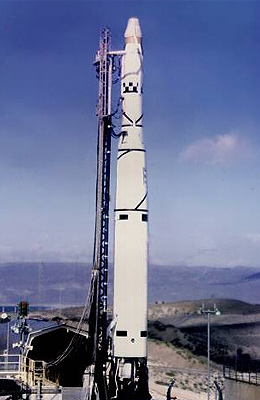

The second stage was an Agena B, built by Lockheed Missiles and Space Systems, Sunnyvale, California. The LV-3A had a total thrust of 456,587 pounds (2,031 kilonewtons). The Atlas rocket used liquid oxygen and RP-1 (a highly-refined kerosene) propellant.

Both engines were built by the Rocketdyne Division of North American Aviation, Inc., at Canoga Park, California. The center, or “sustainer,” engine is a LR105-NA-5, rated at 86,800 pounds of thrust (386 kilonewtons). This stage produced approximately 369,800 pounds of thrust (1,645 kilonewtons). The “half-stage,” was a booster section consisting of two LR89-NA-5 rocket engines. The LV-3A is a “1-½ stage” liquid-fueled rocket with three engines. The maximum width across the booster section was 4.88 meters (16 feet). The Atlas Agena B first stage was 20.70 meters (67 feet, 11 inches) long, with a maximum diameter of 3.05 meters (10 feet). The height of the total vehicle, including the protective shroud encasing Mariner, 103 feet, 5 inches (31.70 meters). Air Force SM-65 Atlas intercontinental ballistic missile (ICBM), and was built by the Convair Division of General Dynamics at San Diego, California. The Atlas Agena B combined an Atlas LV-3A rocket with an Agena B upper stage. The Mariner 1 mission failed when the launch vehicle veered off course and was destroyed by the Range Safety Officer, 4 minutes, 53 seconds into its flight, 22 July 1962. The spacecraft were designed to obtain radiometric temperatures of Venus, and to measure the Interplanetary Magnetic Field. Mariner 1 and 2 were identical space probes built by the Jet Propulsion Laboratory (JPL) of the California Institute of Technology (Caltech), Pasadena, California. This was the second space probe to be sent to Venus. (NASA)Ģ7 August 1962: At 06:53:14 UTC (2:53 a.m., Eastern Daylight Time), Mariner 2 lifted off from Launch Complex 12 at Cape Canaveral Air Force Station, Florida, aboard an Atlas-Agena B launch vehicle. To illustrate how average images of this sequence look, I also have added another set that shows roughly the same detail, such as thicker upper-end and some albedo variations.Engine ignition of Mariner 2 Atlas Agena B at LC-12, Cape Canaveral AFS, 2:53 a.m., EST, 27 August 1962. The image above is the best from the video-sequence. Even differences in thickness of the Agena can be recognized clearly from that distance. To my surprise, the best frames clearly showed the shape and even more. But the Agena is a pretty long shaped rocket stage, so I hoped to see at least the elongated appearance. It is not an easy object to photograph: brightness was at the limit for high-resolution imaging with my setup and an upper stage at 818 kilometers distance is pretty small. It wasn’t until October 2014 that I processed these three year old images of 50 year old rockets. Over the years I have developed better techniques and I knew in 2011 that my processing technique was developing and making progress. I captured the Agena in September 2011 with a 10 inch reflecting telescope on video. Thanks to the considerable altitude, it is still in orbit after 50 years. Exactly at that altitude we find the old spent Agena upper stage from this launch. The two satellites were released at an alititude of around 800 kilometers. Their purpose was probably to test military spaceflight technology. On January 19, 1964, a Thor Agena D SLV-2 rocket lifted up from the Vandenberg SLC2W complex with the two military satellites OPS 3367A and OPS 3367B. The Agena rocket in the picture is pretty much the same type as used for the Gemini flights but without the docking adapter and in its original configuration.

In 1966, Neil Armstrong and David Scott performed the first ever docking of two spacecraft in orbit with Gemini-8 and the Agena. The Agena-D rocket upper stage is best known from the Gemini-era as the Agena Target Vehicle (ATV). I was intrigued by the fact that the technique used to photograph this object wasn’t actually available at the time of launch. That is what the following pictures are about. Imagine seeing the remains of a rocket launch from 50 years ago, as a fossil of spaceflight history in orbit.

The Thor Agena B with Discoverer 37 on the launch pad Jan.


 0 kommentar(er)
0 kommentar(er)
